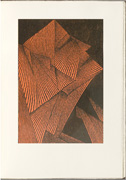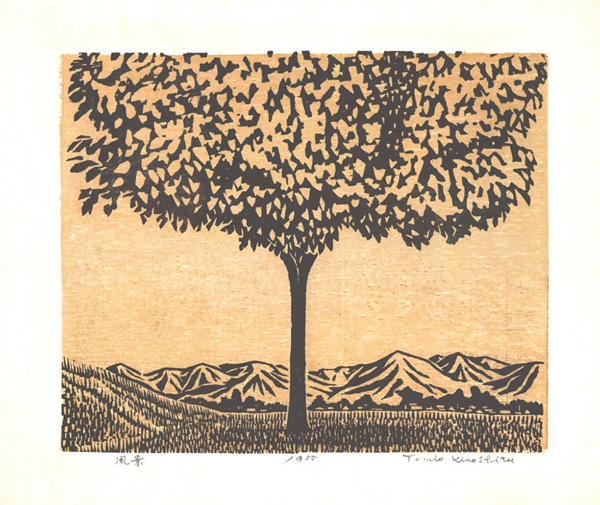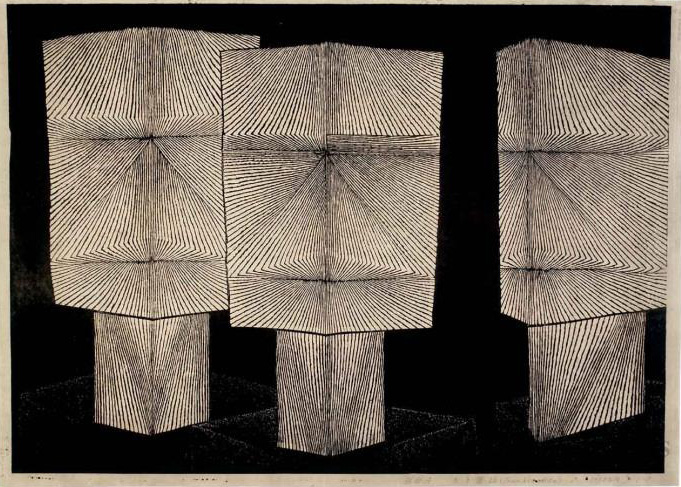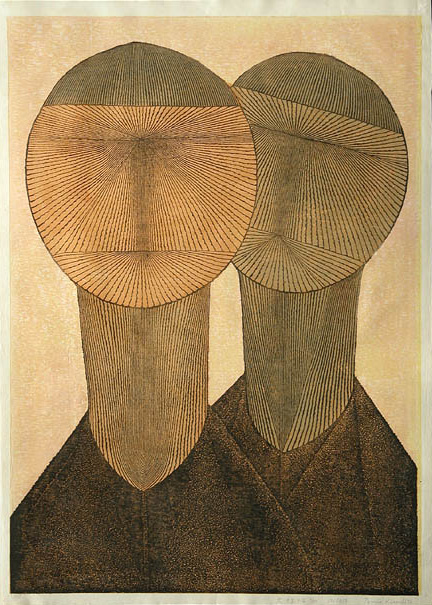Biographical Data
Profile
Kinoshita Tomio 木下富雄 (1923-2014)1...I am trying to express the sufferings of society, of man, of mankind, of all living beings. I am not too certain of my results: perhaps in the end I have produced mere ‘prints'. - The Modern Japanese Print - An Appreciation, James Michener.
Tomio Kinoshita was born January 10, 1923 in the fishing village of Fusuhara-cho (now Yokkaichi City) in Mie Prefecture. After his graduation in 1941 from the Nagoya City Crafts High School1 (Nagoya shiritsu kōgei gakkō), Kinoshita was sent to Manchuria to work as a lens polisher, but a bout of sickness led him to be repatriated to Japan after two years. After his return to Japan, he learned the art of seal carving from his wife.2 Originally an oil painter, Kinoshita started making prints in 1955 and exhibited at the Nihon Hanga Kyōkai (Japanese Print Association) in 1957, winning their Association Prize in 1958. From 1960 to 1966 he was a member of the Kokuga kai (National Painting Association) and from 1966 onward, he submitted works annually to the Nihon Hanga Kyōkai exhibitions. In the 1980s, Kinoshita ceased making prints and stopped exhibiting, except for submissions to the Nihon Hanga Kyōkai.3 He returned to seal carving to make a living. For Kinoshita, print making was undertaken “simply for the pleasure” without regard for commercial gain.
The artist lists his hobbies as books, movies and sports.
There seems to be no English language information on what the artist was up to since he stopped making prints in the 80s. However, the Japan Print Association informed me that he last exhibited with them at their 62nd exhibition in 1994.4
1 The artist's birth and death dates are taken from information on the website of the MIE Prefectural Art Museum http://www.bunka.pref.mie.lg.jp/art-museum/da/detailauthor?authorcd=764304&language=jp&index=0&flg=2
2 I have used Merritt's information for the name of the school Kinoshita graduated from in 1941. The school is also names as Nagoya College of Industrial Art, Nagoya School of Industrial Arts, Nagoya Municipal College of Art and Nogoya City Technological School by other sources.)
3 These intricately carved “chops” are used by Japanese as their official signature.
4 I have not been able to determine when his last submission to the JPA was made.
5 e-mail received on 2-14-12.
Artistic Career
Sources: Guide to Modern Japanese Woodblock Prints: 1900-1975, Helen Merritt, University of Hawaii Press, 1992, p. 66-67; Collecting Modern Japanese Prints, Then and Now, Mary and Norman Tolman, Charles E. Tuttle Company, 1994, p. 122. and p. 228-229; Who's Who in Modern Japanese Prints, Frances Blakemore, Weatherhill, 1975, p. 82; The Modern Japanese Print - An Appreciation, James Michener, Charles E. Tuttle Co., 1968, p. 32-34; and as footnoted
In commenting on Kinoshita’s heads, Jenkins observes: “Carefully arranged with the overall harmony of the print in mind, they may be angular, square, round, or oval, but oval and square faces never appear together in a single composition. Though without sex or race, these faces are intensely human and capable of evoking a range of emotions, from mirth to great sadness.”4
In a 2005 exhibition catalog of modern Japanese prints, Kinoshita’s work Mask (1) below is described by the curators as appearing “to have been carved from blocks of wood,” having a “primitive and archetypal quality.” They go on to say, "There is something at once strong and mournful about these heads, which seem to be engaged in a kind of silent dialogue."5
Until 1962 Kinoshita applied a thin wash of sumi to tone down the entire picture, being violently averse to bright colors at that time. What is more, he does not like to repeat the same coloring.
Petit notes that "[h]is development is quiet and regular, for he works at his own rhythm. There is a direct relationship, he says, between the arduous work involved in cutting the wood and printing, and the quality of the print. Kinoshita’s reverence for excellence in manual skill is one sign of the straightforward honesty permeating his prints."
He exhibited with Nihon Hanga Kyōkai (Japan Print Association) from 1957, Kokugakai (National Picture Association) from 1958 and was a member of Nihon Hanga Kyōkai from 1959 and a member of Kokugakai.
His works are in the collections of major museums around the world including the British Museum; London National Gallery; New York Museum of Modern Art; Los Angeles County Museum of Art; Brooklyn Museum; Art Institute of Chicago: Philadelphia Museum; Houston Museum, Honolulu Academy of Arts; Oregon State University, Corvallis; Portland Art Museum; Art Gallery of Greater Victoria; University of Calgary; Niigata Prefectural Museum of Modern Art and Mie Prefectural Art Museum (which holds the largest collection of the artist’s prints.)
1 Images of a Changing World: Japanese Prints of the Twentieth Century, Donald Jenkins, Portland Art Museum, 1983, p. 131.
2 44 Modern Japanese Print Artists, Gaston Petit, Kodansha International Ltd., 1973, p. 186.
3 The Modern Japanese Print - An Appreciation, James Michener, Charles E. Tuttle Co., 1968, p. 32.
4 Op. cit. Jenkins, p. 131.
5 Modern Impressions: Japanese Prints from the Berman and Corazza Collections 1950-1980, Frank L. Chance and Matthew Mizenko, Philip and Muriel Berman Museum of Art at Ursinus College, 2005, p. 90.
6 Who's Who in Modern Japanese Prints, Frances Blakemore, Weatherhill, 1975, p. 80.
7 Website of Saru Gallery http://www.sarugallery.com/japanese_woodblock_prints_ukiyoe/artists/tomio_kinoshita.html
8 Op. cit. Michener, p. 32.
9 Collecting Modern Japanese Prints, Then and Now, Mary and Norman Tolman, Charles E. Tuttle Company, 1994, p. 122.
10 Op. cit. Petit, p. 186.
4 I have not been able to determine when his last submission to the JPA was made.
5 e-mail received on 2-14-12.
Artistic Career
Sources: Guide to Modern Japanese Woodblock Prints: 1900-1975, Helen Merritt, University of Hawaii Press, 1992, p. 66-67; Collecting Modern Japanese Prints, Then and Now, Mary and Norman Tolman, Charles E. Tuttle Company, 1994, p. 122. and p. 228-229; Who's Who in Modern Japanese Prints, Frances Blakemore, Weatherhill, 1975, p. 82; The Modern Japanese Print - An Appreciation, James Michener, Charles E. Tuttle Co., 1968, p. 32-34; and as footnotedHe learned how to depict the branches of trees by closely observing the works of Hiratsuka. Instead of cutting both sides parallel to the line to be printed, Kinoshita cuts away from this line unevenly with a flat gouge. | Largely a self-taught artist, Kinoshita Tomio primarily painted in oils until 1955-1956, when inspired by the work of Hiratsuka Un'ichi (1895-1997), he began to design prints of Yokkaichi scenery, as in the 1955 print to the left. While inspired by Hiratsuka, Donald Jenkins states, “he has learned as much from studying the art of the past – particularly the woodcuts of Dürer and Cranach – as he has from any living teacher.”1 As to his paintings, no examples can be found. Petit reports that the artist “either gave away many of his paintings or destroyed them,” much to his regret.2 While his first prints were copies of his own paintings and of local landscapes, in 1957 Kinoshita “startled the Tokyo art world … with a series of large prints of… stylized human heads in only black and one other color, done in a striking new style.”3 In 1958, Kinoshita began to diversify his colors. |
| Mask #4, 1957 Honolulu Art Academy Dimensions: 23 1/8 x 28 1/4 in. (58.8 x 71.8 cm) Credit Line: Gift of James A. Michener, 1984 (19268) Object Number: 19268 Other Title: Kana: かめん の お Kanji : 仮面の四 | Big Boys,1958 Dimensions: approx. 32 x 23" Floating World Gallery archive |
In a 2005 exhibition catalog of modern Japanese prints, Kinoshita’s work Mask (1) below is described by the curators as appearing “to have been carved from blocks of wood,” having a “primitive and archetypal quality.” They go on to say, "There is something at once strong and mournful about these heads, which seem to be engaged in a kind of silent dialogue."5
Masks (1)
approx. 24 x 36"
approx. 24 x 36"
Print Making
For Kinoshita, the real pleasure in life is the physical act of carving. Subsequently he prints a few copies simply to enjoy the nuances of the result. Those few copies are all that is necessary for his artistic satisfaction. He wants to make prints only when he feels in the mood to tackle a piece of wood and carve something creative in it. He does not want to be coerced into a commitment simply because some art lover is out there waiting. He prints “as needed,” dating the impressions with the print date rather than the date when the original block was carved.Until 1962 Kinoshita applied a thin wash of sumi to tone down the entire picture, being violently averse to bright colors at that time. What is more, he does not like to repeat the same coloring.
Petit notes that "[h]is development is quiet and regular, for he works at his own rhythm. There is a direct relationship, he says, between the arduous work involved in cutting the wood and printing, and the quality of the print. Kinoshita’s reverence for excellence in manual skill is one sign of the straightforward honesty permeating his prints."
Carving Style
| Kao 3 (Faces No.3), 1959-61 The Modern Japanese Print - An Appreciation Notes: carved on two Judas-tree boards and printed on natural-color torinoko paper; self-printed with carmine and vermilion water colors mixed to obtain the orange, which was impressed three times; sumi ink for the black, impressed twice. | "What Kinoshita has borrowed from Cranach and Dürer is their methods of varying the width of lines in order to create depth and dimension. But, whereas the Europeans were aiming at realism, Kinoshita’s prints are directed toward creating emotional response."6His face and mask prints are composed of characteristic jagged lines, that can be traced back to Hiratsuka’s influence. "He cuts many of his blocks entirely with a single cutting tool, either a flat chisel or a U-shaped gouge (komasuki)," creating "jagged parallel lines to define shapes such as the faces and bodies of partly abstracted human beings."7 James Michener, in describing the artist's prints, states, “... the chief characteristic of the prints is the jagged line which the artist used to convey the sense of grain in the wood..., an artistic invention that which, as so often happens, turns out to be superior to realism."8 "When looking at Kinoshita’s prints, one can immediately see that the boldly carved lines are cut by a master seal carver’s sure hand, and the carving is intrinsic to the drama presented by these very expressive humanoid forms."9Kinoshita’s technique, using black jagged lines which are “bold but controlled and often cut parallel, gives a maximum of intensity. Even though these lines may converge at the eyes, nose, or mouth, no matter from what angle the face is depicted, no matter whether its form is square or oblong, it always remains static. Its life lies beyond. The real face is concealed or disguised, enveloped in its interiority as if in a shroud.”10 |
Prizes, Exhibitions, Collections
Winner of the highest prize of the Japan Print Association Exhibition in 1958 and the Seattle Thirty-first International Print Exhibition in 1960, Kinoshita was represented in many international competitions including Northwest 1960, Philadelphia International Prints Exhibition 1963, and the Tokyo Biennale 1962 and 1968.He exhibited with Nihon Hanga Kyōkai (Japan Print Association) from 1957, Kokugakai (National Picture Association) from 1958 and was a member of Nihon Hanga Kyōkai from 1959 and a member of Kokugakai.
His works are in the collections of major museums around the world including the British Museum; London National Gallery; New York Museum of Modern Art; Los Angeles County Museum of Art; Brooklyn Museum; Art Institute of Chicago: Philadelphia Museum; Houston Museum, Honolulu Academy of Arts; Oregon State University, Corvallis; Portland Art Museum; Art Gallery of Greater Victoria; University of Calgary; Niigata Prefectural Museum of Modern Art and Mie Prefectural Art Museum (which holds the largest collection of the artist’s prints.)
1 Images of a Changing World: Japanese Prints of the Twentieth Century, Donald Jenkins, Portland Art Museum, 1983, p. 131.
2 44 Modern Japanese Print Artists, Gaston Petit, Kodansha International Ltd., 1973, p. 186.
3 The Modern Japanese Print - An Appreciation, James Michener, Charles E. Tuttle Co., 1968, p. 32.
4 Op. cit. Jenkins, p. 131.
5 Modern Impressions: Japanese Prints from the Berman and Corazza Collections 1950-1980, Frank L. Chance and Matthew Mizenko, Philip and Muriel Berman Museum of Art at Ursinus College, 2005, p. 90.
6 Who's Who in Modern Japanese Prints, Frances Blakemore, Weatherhill, 1975, p. 80.
7 Website of Saru Gallery http://www.sarugallery.com/japanese_woodblock_prints_ukiyoe/artists/tomio_kinoshita.html
8 Op. cit. Michener, p. 32.
9 Collecting Modern Japanese Prints, Then and Now, Mary and Norman Tolman, Charles E. Tuttle Company, 1994, p. 122.
10 Op. cit. Petit, p. 186.

-ihl-cat-85599b29c85670f1.jpg)



-600x408-web.jpg)
-by-Kinosh-fb29ed1d4d8fb9fa.jpg)